You have no items in your shopping cart.
Anti-DDX1 Antibody (monoclonal, 11E5)
Catalog Number: orb738416
| Catalog Number | orb738416 |
|---|---|
| Category | Antibodies |
| Description | Anti-DDX1 Antibody (monoclonal, 11E5). Tested in Flow Cytometry, IHC, WB applications. This antibody reacts with Human, Mouse, Rat. |
| Species/Host | Mouse |
| Clonality | Monoclonal |
| Clone Number | 11E5 |
| Tested applications | FC, IHC, WB |
| Reactivity | Human, Mouse, Rat |
| Isotype | Mouse IgG2b |
| Immunogen | E.coli-derived human DDX1 recombinant protein (Position: K562-F740). |
| Concentration | Adding 0.2 ml of distilled water will yield a concentration of 500 μg/ml. |
| Form/Appearance | Lyophilized |
| Conjugation | Unconjugated |
| MW | 88 kDa |
| UniProt ID | Q92499 |
| Storage | Maintain refrigerated at 2-8°C for up to 2 weeks. For long term storage store at -20°C in small aliquots to prevent freeze-thaw cycles. |
| Alternative names | Eukaryotic translation initiation factor 6; eIF-6; Read more... |
| Note | For research use only |
| Application notes | Western blot, 0.1-0.25μg/ml, Human, Mouse, Rat Immunohistochemistry (Paraffin-embedded Section), 2-5μg/ml, Human, Mouse, Rat Flow Cytometry (Fixed), 1-3μg/1x106 cells, Human. Add 0.2ml of distilled water will yield a concentration of 500ug/ml |
| Expiration Date | 12 months from date of receipt. |

Flow Cytometry analysis of MCF-7 cells using anti-DDX1 antibody. Overlay histogram showing MCF-7 cells (Blue line). To facilitate intracellular staining, cells were fixed with 4% paraformaldehyde and permeabilized with permeabilization buffer. The cells were blocked with 10% normal goat serum. And then incubated with mouse anti-DDX1 Antibody (1 µg/1x10^6 cells) for 30 min at 20°C. DyLight®488 conjugated goat anti-mouse IgG (5-10 µg/1x10^6 cells) was used as secondary antibody for 30 minutes at 20°C. Isotype control antibody (Green line) was mouse IgG (1 µg/1x10^6) used under the same conditions. Unlabelled sample without incubation with primary antibody and secondary antibody (Red line) was used as a blank control.
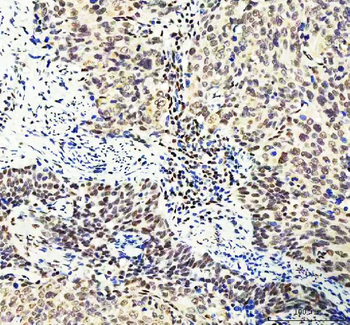
IHC analysis of DDX1 using anti-DDX1 antibody. DDX1 was detected in a paraffin-embedded section of human cervica squamous carcinoma tissue. Heat mediated antigen retrieval was performed in EDTA buffer (pH8.0, epitope retrieval solution). The tissue section was blocked with 10% goat serum. The tissue section was then incubated with 2 µg/ml mouse anti-DDX1 Antibody overnight at 4°C. Peroxidase Conjugated Goat Anti-mouse IgG was used as secondary antibody and incubated for 30 minutes at 37°C. The tissue section was developed using HRP Conjugated Mouse IgG Super Vision Assay Kit with DAB as the chromogen.
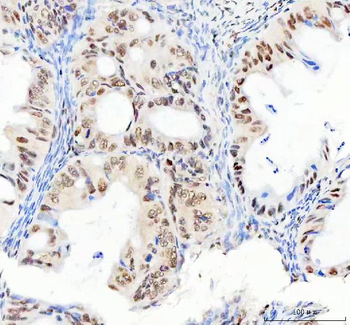
IHC analysis of DDX1 using anti-DDX1 antibody. DDX1 was detected in a paraffin-embedded section of human ovarian serous adenocarcinoma tissue. Heat mediated antigen retrieval was performed in EDTA buffer (pH8.0, epitope retrieval solution). The tissue section was blocked with 10% goat serum. The tissue section was then incubated with 2 µg/ml mouse anti-DDX1 Antibody overnight at 4°C. Peroxidase Conjugated Goat Anti-mouse IgG was used as secondary antibody and incubated for 30 minutes at 37°C. The tissue section was developed using HRP Conjugated Mouse IgG Super Vision Assay Kit with DAB as the chromogen.

IHC analysis of DDX1 using anti-DDX1 antibody. DDX1 was detected in a paraffin-embedded section of human prostatic acinar adenocarcinoma tissue. Heat mediated antigen retrieval was performed in EDTA buffer (pH8.0, epitope retrieval solution). The tissue section was blocked with 10% goat serum. The tissue section was then incubated with 2 µg/ml mouse anti-DDX1 Antibody overnight at 4°C. Peroxidase Conjugated Goat Anti-mouse IgG was used as secondary antibody and incubated for 30 minutes at 37°C. The tissue section was developed using HRP Conjugated Mouse IgG Super Vision Assay Kit with DAB as the chromogen.
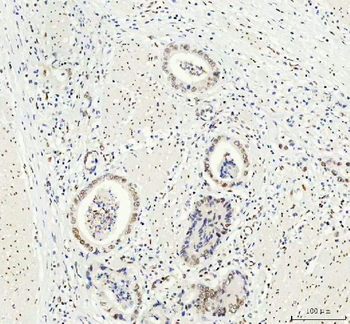
IHC analysis of DDX1 using anti-DDX1 antibody. DDX1 was detected in a paraffin-embedded section of human rectum adenocarcinoma tissue. Heat mediated antigen retrieval was performed in EDTA buffer (pH8.0, epitope retrieval solution). The tissue section was blocked with 10% goat serum. The tissue section was then incubated with 2 µg/ml mouse anti-DDX1 Antibody overnight at 4°C. Peroxidase Conjugated Goat Anti-mouse IgG was used as secondary antibody and incubated for 30 minutes at 37°C. The tissue section was developed using HRP Conjugated Mouse IgG Super Vision Assay Kit with DAB as the chromogen.
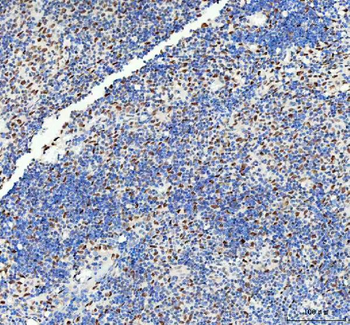
IHC analysis of DDX1 using anti-DDX1 antibody. DDX1 was detected in a paraffin-embedded section of human spleen tissue. Heat mediated antigen retrieval was performed in EDTA buffer (pH8.0, epitope retrieval solution). The tissue section was blocked with 10% goat serum. The tissue section was then incubated with 2 µg/ml mouse anti-DDX1 Antibody overnight at 4°C. Peroxidase Conjugated Goat Anti-mouse IgG was used as secondary antibody and incubated for 30 minutes at 37°C. The tissue section was developed using HRP Conjugated Mouse IgG Super Vision Assay Kit with DAB as the chromogen.
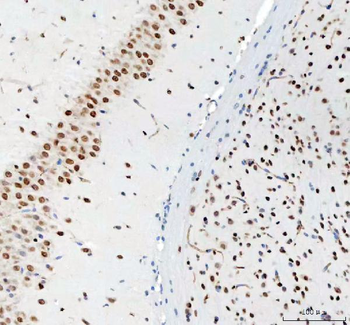
IHC analysis of DDX1 using anti-DDX1 antibody. DDX1 was detected in a paraffin-embedded section of mouse brain tissue. Heat mediated antigen retrieval was performed in EDTA buffer (pH8.0, epitope retrieval solution). The tissue section was blocked with 10% goat serum. The tissue section was then incubated with 2 µg/ml mouse anti-DDX1 Antibody overnight at 4°C. Peroxidase Conjugated Goat Anti-mouse IgG was used as secondary antibody and incubated for 30 minutes at 37°C. The tissue section was developed using HRP Conjugated Mouse IgG Super Vision Assay Kit with DAB as the chromogen.

IHC analysis of DDX1 using anti-DDX1 antibody. DDX1 was detected in a paraffin-embedded section of rat brain tissue. Heat mediated antigen retrieval was performed in EDTA buffer (pH8.0, epitope retrieval solution). The tissue section was blocked with 10% goat serum. The tissue section was then incubated with 2 µg/ml mouse anti-DDX1 Antibody overnight at 4°C. Peroxidase Conjugated Goat Anti-mouse IgG was used as secondary antibody and incubated for 30 minutes at 37°C. The tissue section was developed using HRP Conjugated Mouse IgG Super Vision Assay Kit with DAB as the chromogen.
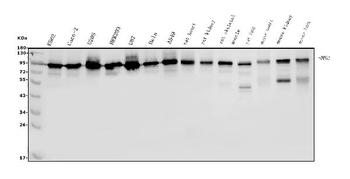
Western blot analysis of DDX1 using anti-DDX1 antibody. Electrophoresis was performed on a 5-20% SDS-PAGE gel at 70V (Stacking gel) / 90V (Resolving gel) for 2-3 hours. The sample well of each lane was loaded with 50 ug of sample under reducing conditions. Lane 1: human K562 whole cell lysates, Lane 2: human CACO-2 whole cell lysates, Lane 3: human U20S whole cell lysates, Lane 4: human HEK293 whole cell lysates, Lane 5: human U87 whole cell lysates, Lane 6: human HELA whole cell lysates, Lane 7: human A549 whole cell lysates, Lane 8: rat heart tissue lysates, Lane 9: rat kidney tissue lysates, Lane 10: rat skeletal muscle tissue lysates, Lane 11: rat lung tissue lysates, Lane 12: mouse heart tissue lysates, Lane 13: mouse kidney tissue lysates, Lane 14: mouse lung tissue lysates. After Electrophoresis, proteins were transferred to a Nitrocellulose membrane at 150 mA for 50-90 minutes. Blocked the membrane with 5% Non-fat Milk/ TBS for 1.5 hour at RT. The membrane was incubated with mouse anti-DDX1 antigen affinity purified monoclonal antibody at 0.25 µg/mL overnight at 4°C, then washed with TBS-0.1% Tween 3 times with 5 minutes each and probed with a goat anti-mouse IgG-HRP secondary antibody at a dilution of 1:10000 for 1.5 hour at RT. The signal is developed using an Enhanced Chemiluminescent detection (ECL) kit with Tanon 5200 system. A specific band was detected for DDX1 at approximately 88 KD. The expected band size for DDX1 is at 88 KD.
Anti-DDX1 Picoband Antibody (monoclonal, 11E5) [orb1882237]
FC, IHC, WB
Human, Mouse, Rat
Mouse
Monoclonal
Unconjugated
100 μgAnti-DDX1 Antibody (monoclonal, 11E5) [orb2602886]
FC, IHC, WB
Human, Mouse, Rat
Mouse
Monoclonal
iFluor647
100 μgAnti-DDX1 Antibody (monoclonal, 11E5) [orb2602887]
FC, IHC, WB
Human, Mouse, Rat
Mouse
Monoclonal
PE
100 μgAnti-DDX1 Antibody (monoclonal, 11E5) [orb2602888]
FC, IHC, WB
Human, Mouse, Rat
Mouse
Monoclonal
APC
100 μgAnti-DDX1 Antibody (monoclonal, 11E5) [orb2602889]
FC, IHC, WB
Human, Mouse, Rat
Mouse
Monoclonal
HRP
100 μg



